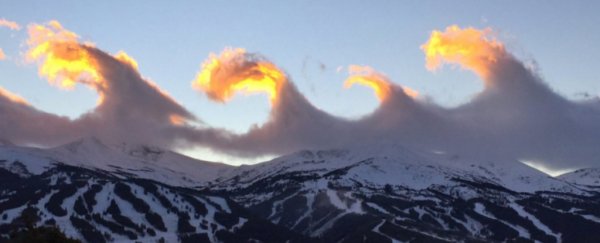These incredible, wave-like clouds were photographed by Breckenridge Resort in Colorado, US, over the weekend, and the Internet has been giving them a whole lot of love ever since.
But although there's been a lot of people calling Photoshop, we're here to tell you that the clouds are real, and there's some good, solid physics to explain why they look like this. And it all comes down to fluid dynamics.
So what's going on here? This effect is a result of what's known as Kelvin-Helmholtz instability. Put very simply, this is something that happens when you have layers of air on top of each other that are moving at different velocities.
That occurs more than you might think, seeing as air behaves in very different ways depending on its temperature, humidity, and the surface it's travelling over.
So now imagine those two different layers of air as two different fluids. Instead of never interacting, the layers are going to try to mix where they meet.
When the top layer of air is moving faster than the bottom layer, this results in that slower air being scooped up, creating a wave-like structure that repeats over and over again until the system normalises itself.
And when a cloud just happens to be caught between those two layers, it results in the beautiful wave-like formation you see above. Sadly, however, these clouds never hang around long, as natural turbulence will eventually collapse the wave.
This doesn't just occur in our atmosphere though. The Kelvin-Helmholtz instability also causes waves on the surface of water when wind blows over it, and it creates the beautiful patterns we see on Saturn's bands, Jupiter's Red Spot, and even the surface of the Sun.
H/t Gizmodo
